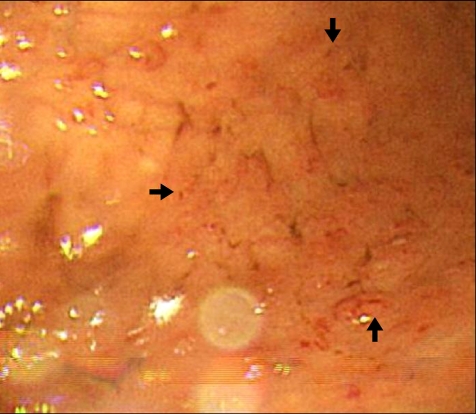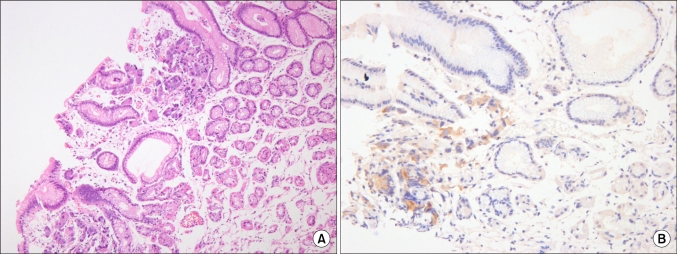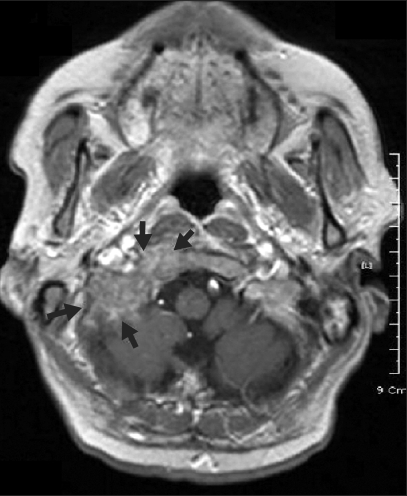Abstract
Prostate cancer commonly manifests with bony metastases. Visceral metastasis can also occur in the lungs and liver. However, stomach metastasis related to prostate cancer is rare. Here, we report a case of prostate cancer metastatic to the stomach. A 66-year-old male was diagnosed with prostate adenocarcinoma. He was noted as having abdominal discomfort, nausea, and vomiting 18 months after the diagnosis. A histopathologic examination and an esophagogastroduodenoscopic gastric biopsy revealed stomach-metastatic adenocarcinoma. He was also noted as having cerebellar metastatic lesions, which were identified by using a brain magnetic resonance imaging (MRI) scan. The patient died of cardiovascular complications 5 months after the diagnosis of stomach metastasis.
Prostate cancer commonly metastasizes to the bones and lymph nodes, but seldom to the lungs or liver. Prostate cancer metastatic to the stomach is also rare. A search of published reports revealed only three cases [1-3]. Here, we present the case of a 66-year-old male with prostate cancer metastatic to the stomach.
A 66-year-old male visited our hospital with painless gross hematuria with blood clots for the previous 1 month. A cystoscopic examination revealed a huge bladder neck mass and a transurethral resection of the bladder tumor (TURBT) was performed. The histology showed an adenocarcinoma of the prostate, with a Gleason score of 9 (5+4). The patient's initial prostate-specific antigen (PSA) was 2.0 ng/ml. Magnetic resonance imaging (MRI), computed tomography (CT), and bone scans did not show metastatic lesions. The clinical stage of prostate cancer was pT4a cN0 cM0 at the time of diagnosis.
The patient underwent a course of prostatic intensity-modulated radiation therapy (IMRT) to 7,800 cGy in 39 fractions 1 month after the diagnosis. An adjuvant treatment of total androgen blockade (TAB) with a luteinizing hormone-releasing hormone (LHRH) agonist and an anti-androgen was administered 3 months after the diagnosis. The patient's PSA level rose to 2.5 ng/ml 7 months after radiation treatment and then rose to 17.9 ng/ml after 9 months. He did not respond to the prostatic IMRT with adjuvant hormonal therapy. A follow-up bone scan showed multiple bone metastases in the thoracic spine, both iliac bones, and the left femur 9 months after radiation treatment. The patient refused chemotherapy with docetaxel. Therefore, we maintained TAB treatment.
The patient complained of abdominal discomfort, nausea, and vomiting 18 months after the diagnosis. Multiple small, elevated mucosal ulcerations on the anterior wall of the gastric antrum were observed by use of esophagogastroduodenoscopy (Fig. 1). An esophagogastroduodenoscopic biopsy of the gastric antrum showed an undifferentiated carcinoma. The histopathology of the gastric biopsy showed infiltration of neoplastic cells with marked atypical nucleoli and abundant eosinophilic cytoplasm (Fig. 2A). The immunohistochemical workup with PSA stain proved metastatic prostate adenocarcinoma (Fig. 2B).
The patient began chemotherapy with docetaxel 19 months after the diagnosis. He was given an intravenous dose of 120 mg (75 mg/m2) docetaxel with prednisolone every 3 weeks for three cycles. The bone and lymph node disease remained stable for several months with an acceptable performance status and no significant treatment-induced toxicity.
The patient complained of facial numbness on the right side 21 months after the diagnosis. A MRI brain scan confirmed an intracerebral mass measuring 2×1.6 cm in the right cerebellum (Fig. 3). Whole-brain radiation therapy was performed.
Pulmonary edema was noted and unfortunately the patient died of cardiac arrest 5 months after the diagnosis of stomach metastasis.
Prostate cancer commonly metastasizes to the bones and lymph nodes; its spread to the gastrointestinal (GI) tract is rare. A search of published reports revealed only three cases of prostate cancer metastatic to the stomach [1-3]. However, there have been reports of prostate cancer metastatic to other sites of the GI tract [4-6]. Two postmortem studies of between 67 and 347 patients with metastatic prostate cancer revealed an incidence of gastric metastasis in 1% to 4% of cases [7,8].
Our patient's initial PSA was lower than in other cases. The initial PSA of the patient in the first case reported by Onitilo et al was 1,565 ng/ml [3].
Our patient had hormone-refractory prostate cancer with systemic tumor disease involving the lymph nodes and bone metastasis. The patient in the first case reported by Onitilo et al had indolent disease before presenting with gastric metastasis. The patient responded rapidly and dramatically to treatment and his GI bleeding and other symptoms were resolved [3].
Our patient died of cardiac arrest 23 months after the initial diagnosis of prostate cancer. The patient in the first case reported by Onitilo et al died 19 months after the initial diagnosis of prostate cancer [3]. Other patients were alive when the reports were published [1-3].
The mechanism of metastasis to the GI tract from prostate cancer is unclear. Hematogenous, lymphatic, and direct infiltrations are the typical routes of spread [9]. Because the prostate is richly supplied with lymphatic channels, most GI spread to the abdomen is via the lymphatic route.
In this and other cases, the most common symptoms associated with stomach metastases from prostate cancer were nausea and vomiting [1-3]. We emphasize that in patients with a history of prostate cancer and new-onset GI manifestations with nausea and vomiting, the elevation of intracranial pressure with brain metastasis and stomach metastasis should be considered in the differential diagnosis.
References
1. Holderman WH, Jacques JM, Blackstone MO, Brasitus TA. Prostate cancer metastatic to the stomach. Clinical aspects and endoscopic diagnosis. J Clin Gastroenterol. 1992; 14:251–254. PMID: 1564301.

2. Christoph F, Grünbaum M, Wolkers F, Müller M, Miller K. Prostate cancer metastatic to the stomach. Urology. 2004; 63:778–779. PMID: 15072903.

3. Onitilo AA, Engel JM, Resnick JM. Prostate carcinoma metastasis to the stomach: report of two cases and review of the literature. Clin Med Res. 2010; 8:18–21. PMID: 20305145.
4. Malhi-Chowla N, Wolfsen HC, Menke D, Woodward TA. Prostate cancer metastasizing to the small bowel. J Clin Gastroenterol. 2001; 32:439–440. PMID: 11319319.
5. Nakamura T, Mohri H, Shimazaki M, Ito Y, Ohnishi T, Nishino Y, et al. Esophageal metastasis from prostate cancer: diagnostic use of reverse transcriptase-polymerase chain reaction for prostate-specific antigen. J Gastroenterol. 1997; 32:236–240. PMID: 9085174.

6. Gore RM, Sparberg M. Metastatic carcinoma of the prostate to the esophagus. Am J Gastroenterol. 1982; 77:358–359. PMID: 7091119.
7. Green LK. Hematogenous metastases to the stomach. A review of 67 cases. Cancer. 1990; 65:1596–1600. PMID: 2311070.

8. Oda I, Kondo H, Yamao T, Saito D, Ono H, Gotoda T, et al. Metastatic tumors to the stomach: analysis of 54 patients diagnosed at endoscopy and 347 autopsy cases. Endoscopy. 2001; 33:507–510. PMID: 11437044.

9. Menuck LS, Amberg JR. Metastatic disease involving the stomach. Am J Dig Dis. 1975; 20:903–913. PMID: 1190198.

FIG. 1
Esophagogastroduodenoscopy: Multiple small elevated mucosal ulcerations on the anterior wall of the gastric antrum are shown (black arrow).

FIG. 2
Histopathology of the gastric biopsy. (A) Infiltration of neoplastic cells with marked atypical nucleoli and abundant eosinophilic cytoplasm (H&E, ×100). (B) Positive response of prostate-specific antigen (PSA) stain: the color of the cytoplasm in neoplastic cells changed to brown (PSA stain, ×200).





 PDF
PDF ePub
ePub Citation
Citation Print
Print



 XML Download
XML Download